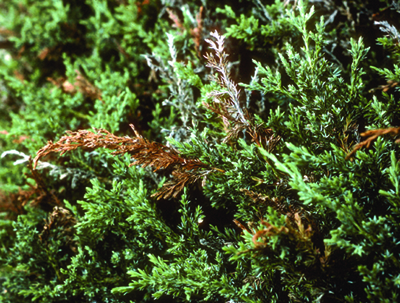Juniper tip blight
July 30, 2015
Cause
Phomopsis juniperovora,and Kabatina juniperi (fungi)
Hosts
Juniper and rarely arborvitae, cryptomeria and chamaecyparis are susceptible to infection by these fungi. Susceptibility varies widely among species and cultivars.
Symptoms
Both fungi produce similar symptoms; time of symptom appearance differs.

Phomopsis infections begin at or near the branch tips of new growth and progress down the stem toward the older growth. Branch tips of infected new growth turn light green, then brown, then ash-gray. New fruiting bodies (pycnidia) can form within 3 to 4 weeks after infection.
Phomopsis tip blight
This fungus overwinters in small black fruiting bodies (~ 0.5 mm in diameter) on dead stems and needles infected the previous year. Spores are released during warm, wet weather and spread primarily through rain splash and overhead irrigation. Symptoms are common during wet, spring weather but may be present whenever new growth is present.
Kabatina tip blight
Infection occurs in fall, but symptoms don’t appear until early spring. Kabatina infects through wounds. Branch tips turn dull green then reddish-brown or yellow. Black fruiting bodies appear in small ash-gray lesions at the bases of the dead tips. Dieback occurs only in early spring. Juniper tips that have died from drought, dog urine or winter injury do not contain pycnidia and fade gradually from brown to green instead of having a sharp line dividing the dead and live tissue.
How it’s spread
Spores can be spread by rain or infested pruning tools.
Management
Send a sample to MSU Diagnostic Services. Accurate diagnosis is made by looking at differences in spores. In general, avoid pruning when foliage is wet; avoid shearing or excessive wounding. When pruning out diseased plant tissue, disinfest pruning tools. Water early in the day to allow foliage to dry before nightfall. Avoid excessive fertilization, as it promotes succulent new growth. When installing new plantings, allow enough space between plants for good air circulation. Treatment timing and fungicide recommendations vary depending on which fungus is present.
Resources for additional information
- Ohio State University Extension Factsheet, Phomopsis and Kabatina Tip Blights of Junipers, HYG-3056-96 online
- BP-29 Juniper Tip Blights Purdue University Cooperative Extension Service West Lafayette, IN 47907 online
Print a PDF of this page: Juniper tip blight.



 Print
Print Email
Email



